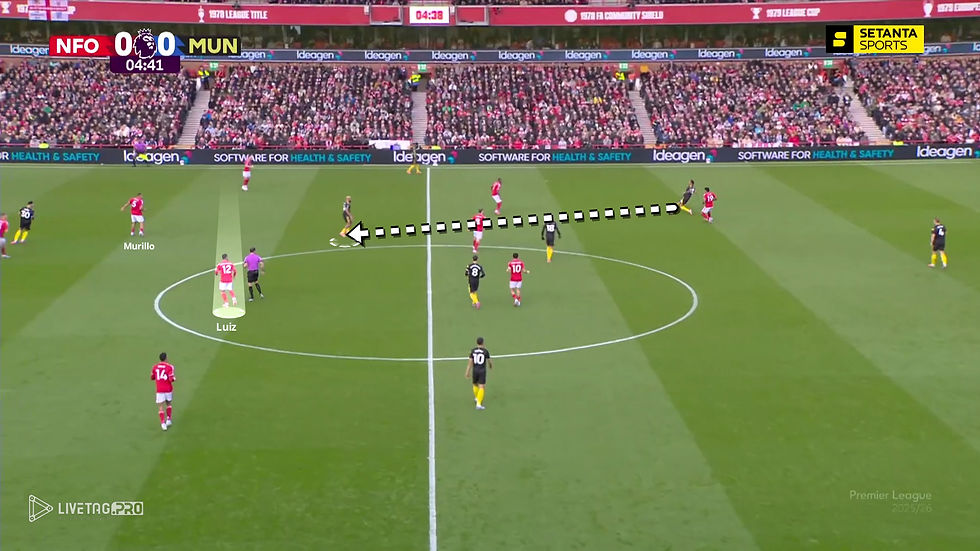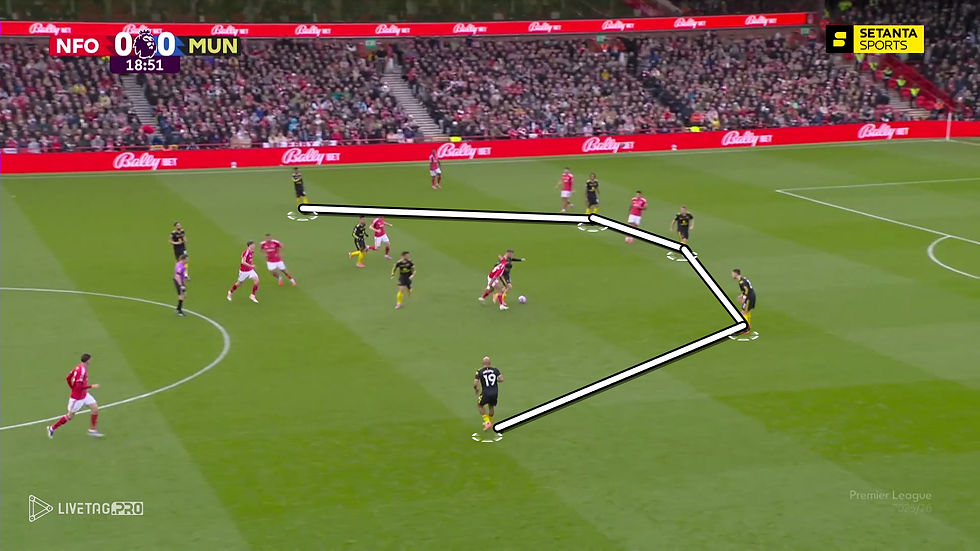NOTTINGHAM FOREST 2-2 MANCHESTER UNITED: MATCH BREAKDOWN
- Matt Smith

- Nov 3
- 7 min read

Nottingham Forest and Manchester United shared the points on Saturday afternoon with a 2-2 draw, with Ruben Amorim’s side rescuing a late equaliser.
It was a game of two sides who are at their best when they don’t have the ball, but United were tasked with showing a little more in possession, with Sean Dyche’s side happy to let them have the ball.
In this article, we’ll look at the in and out of possession shapes of both sides, looking at how they looked to exploit each other’s weaknesses.
Forest out of possession

Forest setup in a 4-4-2 shape out of possession, with Morgan Gibbs-White joining Igor Jesus on the last line of defence. When Jesus and Gibbs-White stepped up to press the centre-backs, this would often leave big gaps between midfield and attack, which United looked to exploit.

Forest would look to press high up the pitch when United had the ball in deeper areas. Nicolo Savona was particularly aggressive in his pressing, stepping up high from the FB position to press Diogo Dalot. United played with a right-footed left wing-back, which meant his body position would often force him inside, which suited United as Bruno Fernandes was able to find space centrally, with Forest’s press fairly frantic, leading to disorganisation.

Gibbs-White and Elliot Anderson would often try and prevent the ball coming into Fernandes or Casemiro, but this would leave space for Bryan Mbeumo to drop off the defensive line to come and receive the ball.

At times, this would drag Murillo out of the defensive shape as Mbeumo was unmarked, and the Forest defender didn’t want him to have space between the lines. This is a bit of a nightmare situation for Dyche, who likes to have his defensive shape very structured.

This would give United a direct out ball in their build-up, looking to exploit the space in behind left by Murillo. Mbuemo would often create these movements to either receive the ball and turn, or drop off and run in behind.

United would look to hit Forest in transition regularly, and as you’ll see above, often producing dangerous situations. Now, just note the body language and positioning of the Forest players…

Perhaps not a tactical observation, but something that will impress Forest fans nonetheless, just look how quickly they were able to get nine bodies back to defend, with the two images just six seconds apart. Very impressive, and despite throwing away a lead, their desire can not be questioned.
Man Utd out of possession

Luke Shaw would often follow a similar pattern to Murillo in terms of jumping out of the defensive line. Shaw would like to prevent a midfield overload, which could occur by Dan Ndoye tucking in, or Gibbs-White dropping into the hole.
This was more effective for United than Forest, and more of a purposeful tactic for United, as they still had the comfort of knowing there were multiple defenders still in shape, due to their five-at-the-back out of possession system.

Forest would regularly try to find Gibbs-White between the lines, who would drop off from United’s defensive line, but Shaw would always look to jump.

As you can see after Shaw wins the ball back, United still have that central three protecting, despite Shaw jumping out, while Amad and Mbeumo now provide the width as wing-backs, with Diogo Dalot tucking in centrally to cover Shaw.

Forest would look to exploit Shaw stepping out at times by having Savona pushing high up the right-hand side and Ndoye tucking in centrally. United wouldn’t always cover with Mbeumo or Matheus Cunha, meaning Dalot was stuck between who to mark, and Ndoye is able to attack the space left by Shaw.
It was a risk worth taking for United as Shaw was often able to win the ball back centrally, and United would usually have enough defensive cover behind.

United would often be in a 5-2-3 out of possession, with Mbeumo and Cunha having the freedom to either cover central areas or press out wide. Due to Shaw stepping out of the defensive line, United didn’t need to worry too much about central overloads, with Forest only playing a midfield two, made into a three when Gibbs-White dropped in.
United were fairly comfortable when Forest had the ball, until the second half when Dyche looked to get his side packing bodies into the box.
Forest in possession

As mentioned, in possession, Savona was almost playing as a second right-winger for Forest. With United playing a high line, Savona was able to make third-man runs in behind the defence, and Forest still kept a solid base with Nico Williams tucking in to make a back three.

Forest would regularly look to try and exploit that space in behind in the first half, bypassing the midfield and trying to overload the attacking areas. This would work better in transitional moments as seen in the earlier picture, as United’s defensive line would be higher up the pitch.

As mentioned, Gibbs-White almost played as a second striker for Forest, creating a partnership with Jesus, not too dissimilar to how Dyche used to setup with Burnley. If Forest couldn’t find Gibbs-White to feet, Jesus would also drop off the defensive line, popping the ball off to Gibbs-White, knowing he was never too far away from him.

In the second half, Forest (right on image above), Forest really upped their crossing numbers, especially in comparison to United (left). Rather than pumping the ball aimlessly, Dyche made a small tweak after the break to try and create overloads at the back post, and also exploit a defensive weakness of United’s.

Gibbs-White would look to attack the back post, with United defending in a flat five, particularly as they looked to protect their lead. Gibbs-White would peel off in order to try and exploit Amad, who is not only not a natural wing-back, but also not a strong player in the air. United would try and cover Jesus in the middle, but Gibbs-White was often able to sneak around the back.

Gibbs-White did exactly the same a few minutes later, peeling off to the back post to sit on Amad, while they were also able to create an overload with Hudson-Odoi waiting. As a result, Gibbs-White leapt above Amad to head home the equaliser.

Forest grabbed another goal just minutes later, and although a bit of a scrappy goal in the box after delivering into the area, there was a clear emphasis from Forest to try and fill the box with bodies, pushing players forward despite the scoreline being level.
Man Utd in possession
Although Ruben Amorim isn’t altering his system, on paper, he’s starting to make tweaks to try and hurt the opposition, and United are benefiting from it.

Their build-up has been an issue this season and the previous under Amorim, but against Forest, who press high and more central, United were able to find a route out through Fernandes dropping deep, before shifting the ball out wide. Shaw, who is out of shot, sat very wide in the build-up, and with Forest narrow in their press, it was fairly simple for United to break out of the press.

Once United broke through the press, they wouldn’t be afraid to then go direct. As mentioned, Forest pressed high up the pitch, meaning they had a high defensive line, and United would try and find Benjamin Sesko in behind.

Another route of United’s build-up was to have Cunha dropping into the midfield two, creating a three. Forest pressed in a 4-4-2, and with Elliot Anderson and Ryan Yates (after Douglas Luiz was subbed) pressing United’s two midfielders, Cunha was able to drop off and find space.

Knowing Cunha is dangerous on the ball, Forest would then react and press, and Cunha’s movement with the ball often created more space for United to exploit.

Cunha can then find Dalot, who is high and wide (a common theme), and due to Cunha being doubled up on, it creates space for Fernandes to receive, before United then look to get in behind again due to Forest’s high line and players jumping out of the defensive shape.

As just mentioned, in possession, United would have their wing-backs high and wide. Forest press narrow, meaning United then have the option to try and find the run of Dalot or Amad, who were usually in space out wide.

United would often target one side, shuffling Forest over, before quickly switching the play to the opposite side. In the previous situation, Casemiro looked to find Dalot with a switch, and above, Fernandes fires the ball out wide to Amad, who was regularly in space and left one v one

As United had previously been targeting the left-hand side, when Amad receives the ball, United are able to flood the back post with bodies. This was a key method of chance creation for Amorim’s side, using their high wing-backs to their advantage.
This would leave Mbeumo and Cunha with the freedom to play in central areas, where they can be dangerous, as they knew they didn’t have to provide the width for the team.
It was, as cliché as it sounds, a game of two halves. In the opening 45, United looked comfortable, able to break through Forest’s press comfortably and regularly looking to exploit their high line. Forest were more aggressive and attacking after the break, looking to fill the box from crosses, and a few minutes of madness got them in front.
Overall, United showed signs of improvement once again from a few months ago, enjoying more success with build-up and varying the way they look to progress the ball from deep.
Forest looked like a Sean Dyche side. High intensity, high pressing, lots of energy, and directness.
Looking for Tools to Help Plan & Write Your Analysis?
Check out the The Coaches Zone store - the #1 destination for football coaches and analysts worldwide. Trusted from grassroots to professional level.

.png)




Comments